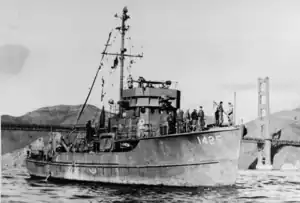USS PCS-1425
USS PCS-1425 was a United States Navy minesweeper and patrol ship in service during World War II. Her keel was laid in 1943 as PC-1425, before being reclassified three months later as a "patrol craft sweeper" (PCS). After the war, the ship served as a test platform for the development of naval radios, being the first ship to demonstrate the use of an automatically aligning UHF directional antenna.[2]
 | |
| History | |
|---|---|
| Name | USS PC-1425 |
| Builder | Hiltebrant Dry Dock Co., Kingston, New York |
| Laid down | 22 January 1943 |
| Renamed | USS PCS-1425, April 1943 |
| Reclassified | Patrol craft sweeper (PCS), April 1943 |
| Launched | 20 July 1943 |
| Commissioned | 4 February 1944 |
| Fate | Transferred to War Shipping Administration January 1947 |
| History | |
| Puget Sound Naval Academy Training Ship | |
| Owner | Puget Sound Naval Academy |
| Acquired | 1950 |
| General characteristics | |
| Class and type | PCS-1376-class minesweeper |
| Displacement | 252 tons |
| Length | 136 ft (41 m) |
| Beam | 24 ft 6 in (7.47 m) |
| Draft | 8 ft 7 in (2.62 m) |
| Propulsion |
|
| Speed | 14.1 knots (26.1 km/h) |
| Complement | 57 |
| Armament |
|
In 1950, she was leased to the Puget Sound Naval Academy for use as a training ship.[3]
References
- Gebhard, Louis (1979). Evolution of Naval Radio-Electronics and Contributions of the Naval Research Laboratory. Naval Research Laboratory. p. 107.
- "Puget Sound Naval Academy". Archived from the original on 2005-02-23.
This article is issued from Wikipedia. The text is licensed under Creative Commons - Attribution - Sharealike. Additional terms may apply for the media files.